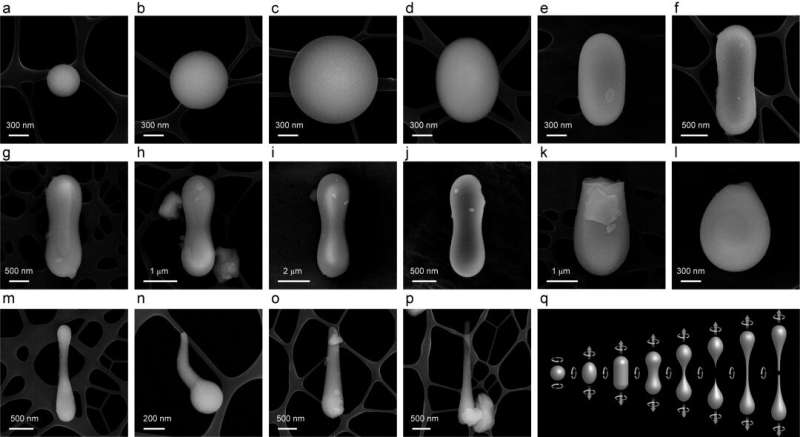This article has been reviewed according to Science X's editorial process and policies. Editors have highlighted the following attributes while ensuring the content's credibility:
fact-checked
trusted source
proofread
Glass fibers in lunar regolith could help build structures on the moon

Through the Artemis Program, NASA plans to send the first astronauts to the moon in over 50 years. Before the decade is over, this program aims to establish the infrastructure that will allow for a "sustained program of lunar exploration and development." The European Space Agency (ESA) also has big plans, which include the creation of a moon Village that will serve as a spiritual successor to the International Space Station (ISS). China and Roscosmos also came together in June 2021 to announce that they would build the International Lunar Research Station (ILRS) around the lunar south pole.
In all cases, space agencies plan to harvest local resources to meet their construction and long-term needs—a process known as in-situ resource utilization (ISRU). Based on samples returned by the fifth mission of the Chinese Lunar Exploration Program (Chang'e-5), a team of researchers from the Chinese Academy of Sciences (CAS) identified indigenous glass fibers for the first time. According to a paper they authored, these fibers were formed by past impacts in the region and could be an ideal building material for future lunar bases.
The work was led by Rui Zhao, Laiquan Shen, Dongdong Xiao, and Chao Chang from the CAS Institute of Physics (IOP) in Beijing. They were joined by researchers from the Center of Materials Science and Optoelectronics Engineering at the University of Chinese Academy of Sciences (UCAS), the Songshan Lake Materials Laboratory, the Qian Xuesen Laboratory of Space Technology, the China Academy of Space Technology (CAST), and the College of Engineering and Applied Sciences at Nanjing University. The team's paper, "Diverse glasses revealed from Chang'E-5 lunar regolith," recently appeared in the National Science Review.
As the IOP team indicated in their paper, lunar glasses are an important component of lunar soils and are produced by various processes. Altogether, they identified five types based on the formation process involved: volcanic, impact, adhered, deposited, and irradiated. These glasses can remain stable for billions of years, providing a geological record of the moon and leading to a better understanding of its formation and evolution. This includes questions relating to the duration of volcanism, the Late Heavy Bombardment, the origins of lunar water, and the presence of a lunar magnetic field.
The team determined that impacts are the most active processes on the lunar surface, as they are "highly heterogeneous in both temporal and spatial scale"—i.e., impacts are an ongoing phenomenon, unlike volcanism and other geological activity that ended billions of years ago. By studying the diverse glasses in the 1.73 kg (3.8 lbs) of lunar regolith returned by Chang'E-5 (CE-5) from the northern mare region Oceanus Procellarum, they were able to clarify their origins and attribute to three main mechanisms: impact, deposition, and irradiation.
As they state, the samples were quite different from those returned by the Apollo astronauts and the Soviet Luna program, suggesting that different mechanisms were at work in Oceanus Procellarum: "Compared with previous Apollo and Luna returned samples that are limited in narrow volcanism ages of 3.9–3.0 Ga and cover only about 4.4% of the lunar nearside surface, the CE-5 samples are collected from the youngest lunar region dated to 2.0 Ga and higher mid-high latitude, allowing the moon to be studied in an extended spatiotemporal range. Preliminary characterizations show that the CE-5 samples are mature samples, but have a significantly lower glass content of 8.3%–20.0% than that of Apollo samples (25.4%–72.3%), implying quite different space environment from Apollo sites."

Upon characterizing the samples' morphological, microstructural, and geochemical properties, the team found that the CE-5 samples contained various glassy materials. As shown in the image above, this included glass particles of various shapes, such as globules, ellipsoids, dumbbells, and teardrops (a to i). They also noted the presence of elongated glass fibers that (based on their elongation) ranged in shape from tadpoles (n), maces (o), and filaments (p). They further concluded that these fibers were formed by molten materials created by impacts that cooled upon contact with the lunar environment.
These fibers would make for a highly effective construction material, consistent with proposals for building lunar bases through ISRU. The IOP team indicated this by addressing previous attempts to fabricate artificial glass fibers from lunar regolith simulants in the lab.
In short, their analysis demonstrated that these fibers could be harvested on the moon and used to fabricate the necessary materials: "[Attempts were made using] lunar simulant materials to fabricate artificial glass fibers in laboratories for future lunar base construction. Our findings directly demonstrate that glass fibers can be produced in-situ on the moon, which could inspire space fabrication of glass fibers such as homogeneous optical fibers and strengthening structural fibers required by future lunar bases."
Before space agencies can construct long-term habitats on the moon, research that characterizes the lunar environment and its resources is absolutely essential. In addition to providing new insight into the many processes that have shaped the lunar surface over time, the IOP study could provide a pathway toward the creation of permanent bases on the moon. This research could also inform future missions to Mars, which NASA and China plan to commence by 2033. These missions include the creation of surface habitats, and further characterization of the Martian environment could lead to specialized construction methods.
More information: Rui Zhao et al, Diverse glasses revealed from Chang'E-5 lunar regolith, National Science Review (2023). DOI: 10.1093/nsr/nwad079
Provided by Universe Today





















